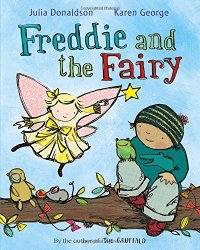by Lee Johnston
We run through a similar bedtime routine every night in our house. After dinner and playtime, our two-and-a-half-year-old daughter is given a bath, followed by “milk and book,” as she calls it. Then she snuggles with either myself or my partner in a big comfy chair in her bedroom – lights dimmed, bottle of warm milk at the ready and a selection of familiar books at our side. Along with being a nice way to bond together at the end of our day, it’s a really interesting time in her life, developmentally speaking. Kathleen is becoming more vocal and opinionated in general, as toddlers are wont to do, and more interactive. My partner and I appreciate being able to spend time with Kathleen focusing on literacy and language skills as she winds down for the day, in a comfortable room without distractions.
When it’s my turn to read, I ask her what book she wants first. I’ve learned her shorthand: “Monkey book” refers to Curious George (“pancake” for the one where he saves the charity breakfast; “chocolate” for the one where he wreaks havoc in a chocolate factory); “Mouse book” refers to the story of Tiny Too-Little, the mouse with a crush on a giraffe who attempts to pile random objects high enough to give her a kiss. There are classics like Corduroy and Goodnight Moon, books recommended by workmates and gifted by friends, and ones depicting stories taken straight from her favorite TV shows (I’m looking at you, Peppa Pig!).
One of the latest additions to the book collection holds a special place in my heart. Freddy and the Fairy is the story of a boy who finds a fairy named Bessie-Belle stuck in a tree. He rescues her and in return she offers to grant his wishes. Unfortunately, she can’t hear very well and has trouble correctly interpreting Freddie’s requests for different kinds of pets. A series of miscommunications ensues, wherein Bessie-Belle grants Freddie a bat instead of a cat, a frog instead of a dog, and so on. Freddie gets frustrated and stamps his feet, and the fairy gets sad and cries. Fortunately, the Fairy Queen appears and explains to Freddy that his habits of mumbling, turning away and putting his hand near his mouth when he’s speaking are impeding his ability to communicate with Bessie-Belle. He learns to communicate more clearly and his wishes for a multitude of pets are granted, with only the occasional slip-up.
Kathleen loved the book from the get-go. Maybe it’s because Bessie-Belle wears hearing aids like her. They’re a subtle blue and often covered by the fairy’s hair, so I’ve pointed them out to her. She nodded in acknowledgement, but seemed more interested in the cat Freddy was envisioning wishing for. Maybe she loves the book because she likes fairies and animals, and can empathize when the fairy is “stuck” and “sad.” Whatever the particular reason, Kathleen’s “Fairy book” quickly became a staple of our nightly routine.
The best part is that it’s actually really good. The illustrations are delightful and the prose stands up to repeated readings. The book’s author, Julia Donaldson, is famous for having written classic children’s books like The Gruffalo and Room on the Broom. She herself is hard of hearing and wears hearing aids, and has commented on how touched she was by the positive response to Freddie and the Fairy, particularly from hard of hearing children who were happy to see hearing aid use depicted in a book. Donaldson has gone on to advocate for more diverse representation of deafness and hearing loss in children’s books. More recently, she has gone on to create a book (What the Jackdaw Saw) about friendship and sign language with a group of deaf children in a workshop organised by a UK-based charitable organization for deaf children and youth called Life & Deaf. If you’re interested in reading more about this author’s belief in inclusion in children’s book and about the development of What the Jackdaw Saw connect to this article.
Now that she’s getting older we’re thinking more about how to increase Kathleen’s access to representations of hearing loss. She has yet to indicate that she has questions about why she wears hearing aids while no one else in her family does. And it’s too soon to say what, if any, role her hearing loss and hearing aid use will play in her identity formation as she grows into her older self. But it’s important that we see ourselves reflected in the world, particularly when we’re children. We’re lucky that we can attend group sessions with other hard of hearing and Deaf children, and that another child attending Kathleen’s daycare wears hearing aids. She has examples of other children to look to for affirmation. But it’s nice to have an example of hearing loss representation in our home, expressed in an entertaining and subtle way. It’s also a nice tool to have to pass on to the Freddie’s of the world – those of us (myself included!) who sometimes take our hearing status for granted, and forget to communicate with others as best we can. I’m looking forward to seeking out more books and representations of hearing loss for our family and home, so they’re there if and when Kathleen needs them.
Unfortunately (for me), Kathleen has a new obsession – Peppa’s First Sleepover. This book doesn’t stand up quite so well to repeated readings, which is too bad as it’s the first book Kathleen has decided must be read no less than three times in a row. Freddy and the Fairy’s waiting patiently on the shelf, however; its time will come back around, I’m sure.


